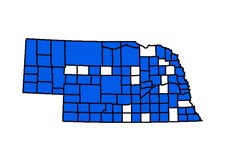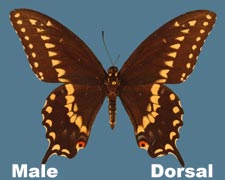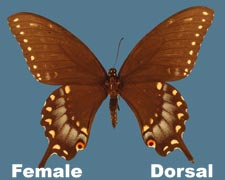
Black Swallowtail |
 |
| Papilio polyxenes asterius (Stoll, 1775) |
| Status: Uncommon to common widespread resident. |
| Flight Period(s): This species is probably at least triple brooded through much of the state. In Nebraska it has been reported from 18 April – 5 October. |
| Range: The Black Swallowtail is found from the Atlantic Coast in the United States and southern Canada west to eastern Saskatchewan and eastern Arizona. It is found thoughout Nebraska. |
| Larval Hostplant(s): Larvae feed on numerous members of the Parsley Family - Apiacea - including Dill (Anethum graveolens), Water Parsnip (Berula erecta), Bulbous Water Hemlock and Water Hemlock (Cicuta bulbifera and C. maculata), Poison Hemlock (Conium maculatum), Honewort (Cryptotaenia canadensis), Wild Carrot (Daucus carota), Aniseroot (Osmorhiza longistylis), Wild Parsnip (Pastinaca sativa), Water Parsnip (Sium suave). Ornamental and garden plants (Dill, Fennel, and Rue) are also utilized. Musineon tenuifolium (a hostplant shared with some of its relatives - ‘Baird’s’ Old World Swallowtail and the Anise Swallowtail, is fed on in the Nebraska panhandle. |
| Overwinter: As pupae. |
| Commentary/Habitat: This species has adapted well to many suburban settings where its caterpillars are frequently encountered on suitable ornamental and garden plants. While most of its wetland and domestic hostplants are upright highly visible plants, many of its upland hostplant species are low growing and diminuative. Adults are similar in appearance to the distasteful Pipevine Swallowtail, which is thought to give them a degree of protection from predators. |
| Similar Species: Pipevine Swallowtail. |

